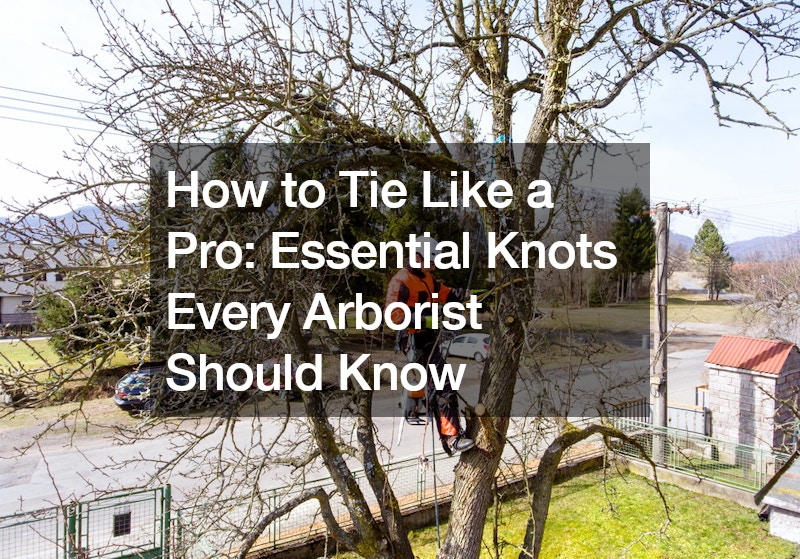In the world of tree care, mastering essential knots is as crucial as knowing your way around a chainsaw. Whether you’re climbing trees to prune branches or setting up rigging systems for tree removal, having a solid grasp of these knots can make your work safer and more efficient. In this article, we’ll cover some of the most essential knots every arborist should know, from the basic Bowline to the versatile Blake’s Hitch.
Bowline: The Arborist’s Best Friend
Let’s start with the Bowline, often hailed as the king of knots in the arborist world. This knot forms a secure loop at the end of a rope, making it ideal for creating an anchor point or securing equipment.
To tie a Bowline, simply form a loop in the rope, pass the working end through the loop, wrap it around the standing part, and pass it back through the loop. Pull tight, and you’ve got yourself a Bowline. Remember, the mnemonic “the rabbit comes out of the hole, around the tree, and back down the hole” can help you remember the steps.
Blake’s Hitch: The Climber’s Companion
Next up is the Blake’s Hitch, a go-to knot for climbers in the arborist community. This friction hitch allows climbers to ascend and descend ropes with ease, providing a reliable grip without compromising on adjustability. To tie a Blake’s Hitch, cross the working end over the standing part, make four wraps around the rope, pass the tail through the resulting loop, and tighten the knot. Remember to always add a safety knot, such as a Figure Eight, to secure the hitch in place.
Alpine Butterfly: The Midline Marvel
For rigging and anchoring tasks, the Alpine Butterfly knot is indispensable. This knot creates a secure loop in the middle of a rope, allowing arborists to attach rigging lines or create adjustable anchor points. To tie an Alpine Butterfly, form a bight in the rope, twist it twice, loop the working end around the twists, and pass it back through the center. Pull tight, and you’ve got yourself a reliable midline knot.
Running Bowline: Versatility at Its Best
When it comes to securing loads or creating temporary anchor points, the Running Bowline shines. This variation of the Bowline allows arborists to quickly create a loop around an object, making it ideal for rigging tasks where adjustability is key. To tie a Running Bowline, wrap the rope around the object, form a loop with the working end, pass it through the loop, and tighten the knot. With the Running Bowline in your arsenal, you’ll be ready for any rigging challenge that comes your way.
Cow Hitch: The Quick and Secure Option
Last but not least, we have the Cow Hitch, a simple yet effective knot for attaching equipment to anchors or rigging points. This knot can be tied quickly with a single strand of rope and provides a secure attachment that can be easily adjusted as needed. To tie a Cow Hitch, pass the rope around the anchor, cross it over itself, and loop it back through the initial loop. Finish off with a couple of half hitches for added security, and you’re good to go.
Advanced Knot Techniques for Arborists
As arborists progress in their careers, mastering advanced knot techniques becomes advantageous. Introducing complex variations like the Distel Hitch or Blake’s Hitch with a Yosemite finish expands their knot tying repertoire, enabling them to tackle diverse tree care tasks with confidence.
Knot Tying Equipment Essentials
Equipping arborists with the right tools enhances knot tying efficiency. Recommending essentials like quality ropes, carabiners, and harnesses ensures reliability and durability during tree care operations. Providing insights on selecting and maintaining knot tying equipment optimizes performance and safety on the job.
Importance of Knot Tying in Tree Care Safety
Mastery of essential knots is paramount for ensuring safety in tree care operations. Properly tied knots secure equipment, anchor points, and harnesses, reducing the risk of accidents and injuries. Understanding the significance of each knot in various tree care scenarios enhances overall safety protocols.
Common Mistakes to Avoid When Tying Knots
Arborists often encounter challenges when tying knots, leading to potential hazards. Highlighting common mistakes such as incorrect knot selection, improper tightening, or insufficient tail length educates arborists on potential pitfalls. Providing insights on error prevention fosters safer work environments.
Conclusion: Mastering Knots for Tree Care Training
In conclusion, mastering essential knots is a must for any arborist serious about their craft. Whether you’re climbing trees, rigging branches, or securing equipment, having a solid foundation in knot tying can make your work safer, more efficient, and more enjoyable. By learning and practicing these essential knots, you’ll be well on your way to becoming a pro arborist. So grab your ropes, start practicing, and elevate your tree care skills to new heights!
.

